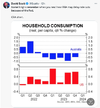Michael Cornips
Formerly known as TradersCircle3
- Joined
- 5 January 2011
- Posts
- 62
- Reactions
- 3
The Gross Domestic Product (GDP) figures came out last week, and as everyone now knows, the headline rate was a fall of 1.2% in March GDP from December GDP. Much is written and analysed about this figure and the implications it has for our economy. It is interesting to analyse the figures in more detail.
GDP figures are reported in two ways: Nominal GDP growth and Real GDP growth. The nominal GDP figure is the actual unadjusted figure using current dollars. The real GDP figure is adjusted by inflation, such that our concern should really be the economy's growth adjusted by inflation. It is of no use if nominal GDP growth is 5% whilst inflation is 7% - it means the economy is going backwards.
Back to the GDP numbers of last week - the fall of 1.2% in the March GDP was a fall in real (inflation adjusted) GDP growth. From March 2010 to March 2011 the growth in real GDP was 1%. But in stark contrast was the nominal GDP growth for one year. Nominal GDP growth was 7.1% from March 2010 to March 2011. This was definitely lower than the 8.9% annual growth the previous quarter, but hardly recessionary. Keep in mind that the Government taxes nominal dollars, not real dollars, so a 7.1% growth rate is not entirely inconsistent with the growth forecast in the May budget.
So what turns a nominal GDP growth of 7.1% into real GDP growth of 1.0% - answer - rising inflation.

The graph shows the downturn in GDP growth rates, but also highlights increased inflation reflected in the GDP deflator.
This is probably the figure that is concerning the RBA when considering the raising of interest rates over the next few months. The recent bad economic news may delay a rate rise today (Tuesday, 7th June) but if the March GDP figure only reflected the effects of the floods on the mining sector, then rates rises are definitely to be expected.

The next graph tracks the GDP deflator, CPI and official RBA interest rates. The GDP deflator rate, implicit in the just released GDP figures, points to rate of 6.1% (ie Nominal growth of 7.1% less real growth of 1%).
The last time the rate was in this range in 2008, the official interest rate was 7.25%.
If I was to try and make a case for an interest rate rise today, I would point to a fall of 1.2% in real GDP for the quarter and a rise of .70% in nominal GDP for the quarter. This points a GDP deflator of 1.9% for the quarter or 7.6% annualised.
The Federal budget, using Treasury figures, is based on a projected investment boom. Any sign that the March 2011 GDP was only affected by the floods, and a sign that the investment boom is commencing, will definitely prompt the RBA to lift interest rates.
Michael Cornips
GDP figures are reported in two ways: Nominal GDP growth and Real GDP growth. The nominal GDP figure is the actual unadjusted figure using current dollars. The real GDP figure is adjusted by inflation, such that our concern should really be the economy's growth adjusted by inflation. It is of no use if nominal GDP growth is 5% whilst inflation is 7% - it means the economy is going backwards.
Back to the GDP numbers of last week - the fall of 1.2% in the March GDP was a fall in real (inflation adjusted) GDP growth. From March 2010 to March 2011 the growth in real GDP was 1%. But in stark contrast was the nominal GDP growth for one year. Nominal GDP growth was 7.1% from March 2010 to March 2011. This was definitely lower than the 8.9% annual growth the previous quarter, but hardly recessionary. Keep in mind that the Government taxes nominal dollars, not real dollars, so a 7.1% growth rate is not entirely inconsistent with the growth forecast in the May budget.
So what turns a nominal GDP growth of 7.1% into real GDP growth of 1.0% - answer - rising inflation.

The graph shows the downturn in GDP growth rates, but also highlights increased inflation reflected in the GDP deflator.
This is probably the figure that is concerning the RBA when considering the raising of interest rates over the next few months. The recent bad economic news may delay a rate rise today (Tuesday, 7th June) but if the March GDP figure only reflected the effects of the floods on the mining sector, then rates rises are definitely to be expected.

The next graph tracks the GDP deflator, CPI and official RBA interest rates. The GDP deflator rate, implicit in the just released GDP figures, points to rate of 6.1% (ie Nominal growth of 7.1% less real growth of 1%).
The last time the rate was in this range in 2008, the official interest rate was 7.25%.
If I was to try and make a case for an interest rate rise today, I would point to a fall of 1.2% in real GDP for the quarter and a rise of .70% in nominal GDP for the quarter. This points a GDP deflator of 1.9% for the quarter or 7.6% annualised.
The Federal budget, using Treasury figures, is based on a projected investment boom. Any sign that the March 2011 GDP was only affected by the floods, and a sign that the investment boom is commencing, will definitely prompt the RBA to lift interest rates.
Michael Cornips






